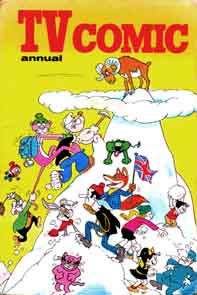The 1976 TV Comic Annual

|
|
Polystyle Publications Ltd The 1976 TV Comic Annual |

|
| Published | 1975 |  |
| SBN (not ISBN) | 85096 048 1 |
| Starring the fourth Doctor and Sarah |
A Review by Finn Clark 2/9/04
It's another load of crap! It's hardly worth talking about the individual strips, since they're all much of a muchness. Disturbingly, Mighty Moth has now become one of the book's best strips. By now it's arguably better than my previously favoured TV Terrors, which for some reason seemed to jump the shark when Hoppit named his boots. Is the apocalypse at hand?
Admittedly there are good points. There's no Texas Ted this year. Dad's Army is still a class act, with characterisation and situations that are faithful to the TV series in a good way. It feels real. There's another Tarzan text story, which may not be great but at least helps to break up the monotony. This year's Doctor Who story is top-notch, but even that isn't enough to make me recommend this book. The thing which most sticks in my mind is the extraordinary extent to which Basil Brush is a snivelling loser. In one story he's about to flee the country because a policeman took his paw print. Some might argue that since that's memorable, in a sense that's a high point of this book.
The Doctor Who story is a five-pager called Woden's Warriors, painted in lovely colour by John M. Burns, a titan of the UK comic book scene. He's the chap who drew part one of Colin Baker's Age of Chaos before Barrie Mitchell took over for parts 2-4. He can't draw Tom Baker to save his life, instead creating a scarf-wearing tooth-monster that probably slithered from the sea alongside Lovecraft's Deep Ones in Innsmouth, but otherwise it's great-looking art. The script's fine, so overall this is a good story. (It was reprinted in Doctor Who Classic Comics 14.)
As an irrelevant aside, two Doctor Who comic strips to date have contained Vikings... Woden's Warriors (4th Doctor) and Doctor Conkeror (7th Doctor). The latter was jolly nonsense salvaged from the cancelled Incredible Hulk Presents magazine and printed in DWM 162; both of these stories are exactly five pages long.
Things I learned from reading this book: